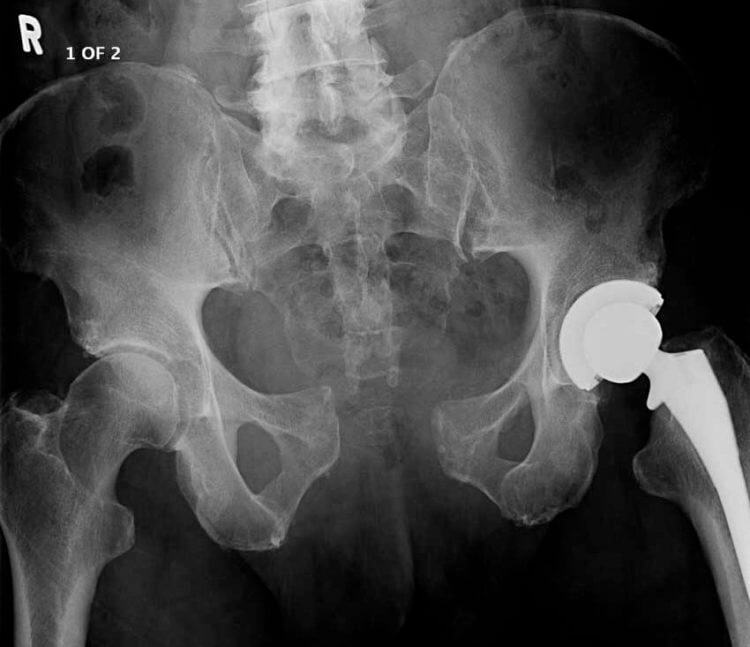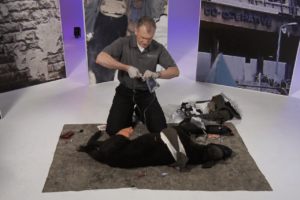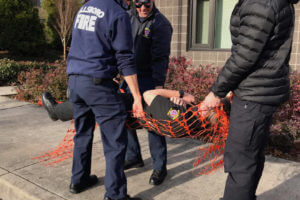
Unstable pelvic fractures can be highly lethal
- Posted by Mike Shertz MD/18D
- Categories Casualty Movement, MARCH
“Pelvic fractures are common in combat injuries and may be highly lethal. Twenty-six percent of service members who died during OIF and OEF had a pelvic fracture.” 1
This led to the TCCC committee adding pelvic binders to their guidelines in November 2016.
Pelvic fractures occur in 22% of casualties with a blast-induced lower extremity amputation. The occurrence increases to 39% if bilateral above the knee amputations are present. 2 A US DOD Performance Improvement project showed similar percentages.
Pelvic fractures also occur in motor vehicle crashes and falls. Hemodynamically unstable bleeding pelvic fractures can have up to a 40% mortality rate.3 Open book pelvic fractures are even more fatal. See the associated x-ray of a man thrown from his horse who complained only of left hip pain.
The only available prehospital treatment option to manage pelvic fractures is pelvic binding. Admittedly, there is no definitive evidence showing a survival benefit with pelvic binders.1
However, there is evidence that pelvic binder placement at the level of the greater trochanter reduces unstable pelvic fractures effectively, results in fewer blood transfusions, shorter length of hospital stay,4 and is unlikely to lead to any major complications.1
Learn MoreTactical Casualty Care course
Physical examination findings can be subtle, like just blood at the meatus and diffuse suprapubic tenderness as was the case in the gentleman whose x-ray is shown. Hematomas above the inguinal ligament, perineum, pelvic instability, and substantial pelvic pain/tenderness are more apparent signs of pelvic fracture.
One key point in the use of pelvic binders is to loosely strap or tape the feet and knees together to prevent external rotation of the lower extremities after the pelvic binder is placed.
For an excellent review of these topics check out “The use of pelvic binders in tactical combat casualty care guidelines proposed change 1602”.
- Shackelford, S, et al. The Use of Pelvic Binders in Tactical Combat Casualty Care, J Spec Oper Med.Spring 2017;17(1):135-147. Available online at Semantic Scholar, (last checked 02 October 2019)
- Cross AM, Davis C, Penn-Barwell J, et al. The incidence of pelvic fractures with traumatic lower limb amputation in modern warfare due to improvised explosive devices. J R Navy Med Serv. 2014;100.2:152–156.
- White CE, Hsu JR, Holcomb JB. Haemodynamically unstable pelvic fractures. Injury 2009;40:1023–1030.
- Fu CY, Wu YT, Liao CH, et al. Pelvic circumferential compression devices benefit patients with pelvic fractures who need transfers. Am J Emerg Med. 2013;31:1432–1436.
You might also be interested in a prior Crisis Medicine article on an improvised pelvic binder technique.
Dr. Mike Shertz is the Owner and Lead Instructor at Crisis Medicine. Dr. Shertz spent over 30 years gaining the experience and insight to create and provide his comprehensive, science-informed, training to better prepare everyday citizens, law enforcement, EMS, and the military to manage casualties and wounded in high-risk environments. Using a combination of current and historical events, Dr. Shertz’s lectures include relevant, illustrative photos, as well as hands-on demonstrations to demystify the how, why, when to use each emergency medical procedure you need to become a Force Multiplier for Good.



